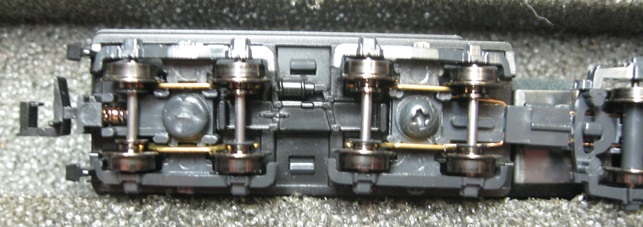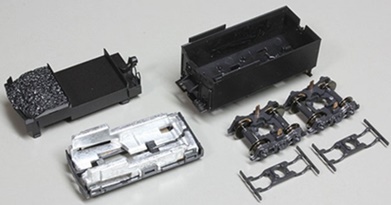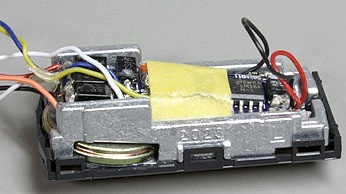C55 2011 -

C55 2012 -

C55 2011 -

C55 2012 -

Introduced: 1992 (re-run in 2011)
Given their limited availability in the US, I don't normally delve into Asian prototype locomotives (the fact that tracking down information about them is damned near impossible doesn't help either). However, I think these models deserve an exception. Given the dearth of really good Pacific-type N scale steamers in the US, this particular 4-6-2 mechanism is a very popular choice amongst North American modelers when it comes to repower/kitbash jobs (particularly those interested in putting a quality mech under their old Minitrix PRR K4s).
The prototypes were built in Japan in the mid-1930's and operated by the Japan National Railroad (JNR). As pictured above, these models are available in two different versions (with the differences basically boiling down to variations in some of the detailing). The drivers measure 11.8 mm (74.3 scale inches). Like most Asian steam models, the shells are a bit oversized for N scale (closer to 1:150 than 1:160). This is due to the fact that most Asian steam locomotive models are based on narrow-gauge prototypes (and yet designed to operate on N gauge track).

The chassis is all metal and split-frame (additional weight can be found inside the boiler shell). The motor is a straight-wound five-poler. Pickup is provided by all eight tender wheels and four of the six drivers (the rearmost driverset being equipped with traction tires). The pilot and trailing trucks are electrically neutral. Current is transferred from the tender to the engine by way of two stiff wires inside the plastic drawbar. A PC board on the front of the chassis provides illumination for the (non-directional) headlight. Unfortunately, said board is equipped with an incandescent bulb rather than an LED. There is no backup light in the tender. The running gear is a mixture of plastic and metal parts. The pilot coupler is a small, non-operational knuckle. Two different replacement couplers (Rapido and Kato knuckle) are included in the box should you want to switch.

The driver axles are mounted inside bearing blocks that seat inside cutouts in the frame. Only the rear two driver axles are geared (with the forward drivers being turned solely by the cranks). Apart from the brass worm, all gearing is plastic. The wheels are blackened and low-profile on the most recent production run (no problems on code-55 track). That said, I'm not sure if the same applies to the original 1992 production run (my impression being that the wheel flanges were downsized with the 2011 run).

The tender coupler is a truck-mounted Rapido (of all things). The tender truck pickup scheme is a bit of a departure from what we're used to seeing from Kato-USA. Instead of axle-tip wipers, these models employ axle-flange wipers.
Performance is absolutely outstanding in every way. Throttle response is smooth at all levels and pickup is perfect. They run whisper quiet, with nary a shake, shimmy or wobble. Slow speed creep is impressive, with mine taking about four seconds to crawl from one tie to the next. Pulling power is strong (no problems at all with ten heavyweight passenger cars on level track). No problems on curves as sharp as 9.75" radius. OK, the gearing is such that the top-end speed is ridiculously high, but that just seems to be the way Kato does things. If it bothers you, don't turn the throttle up that high.
On the downside, the drivers are a potential source of trouble. Given that they are not keyed on their axles, it is possible that they can slip (and thus get out of quarter with each other). Fortunately, requartering them and then applying a bit of Loctite solves the problem (should it ever occur). Another more serious concern (at least for me) is the complete lack of DCC support.
Overall though, these are tremendous performers and certainly grist for the kitbashing mill. Interested parties are urged to check out Tsuguo Ebihara's article in the 2007 NTrak Steam Locomotive Addendum where he takes a Kato C55 and a Minitrix K4 and bashes them into this little beauty -

Kato also makes a C57 Pacific. And unlike the C55, this one has boxpok (as opposed to spoked) drivers -

C57-180 -

C57-192 -

Interestingly enough, the internal design on at least one of these models (#2007-2, released in 2014) is quite a departure from the C55 -

I'm not sure if Kato is migrating this new design to all of their JNR Pacifics. But in any case, I'm told that installing DCC in the tender of one of these newer C57's (and then running wires up to the motor and headlight) is a much simpler proposition than it is on the old C55's. Vis -


Note that I have never actually owned any of these C57's, but my assumption is that they run at least as well as the C55's.
To remove the locomotive shell, spread the sides apart back by the cab. This will free the shell from the two bumps on the frame that hold it in place. Once freed up, the shell should slide forward and off. To remove the top of the tender shell, remove the screw from the forward tender truck. The top (along with its attached weight) will then lift out.
Grade: A